weight BMW 5 SERIES GRAN TURISMO 2014 F07 Owner's Manual
[x] Cancel search | Manufacturer: BMW, Model Year: 2014, Model line: 5 SERIES GRAN TURISMO, Model: BMW 5 SERIES GRAN TURISMO 2014 F07Pages: 259, PDF Size: 5.68 MB
Page 61 of 259
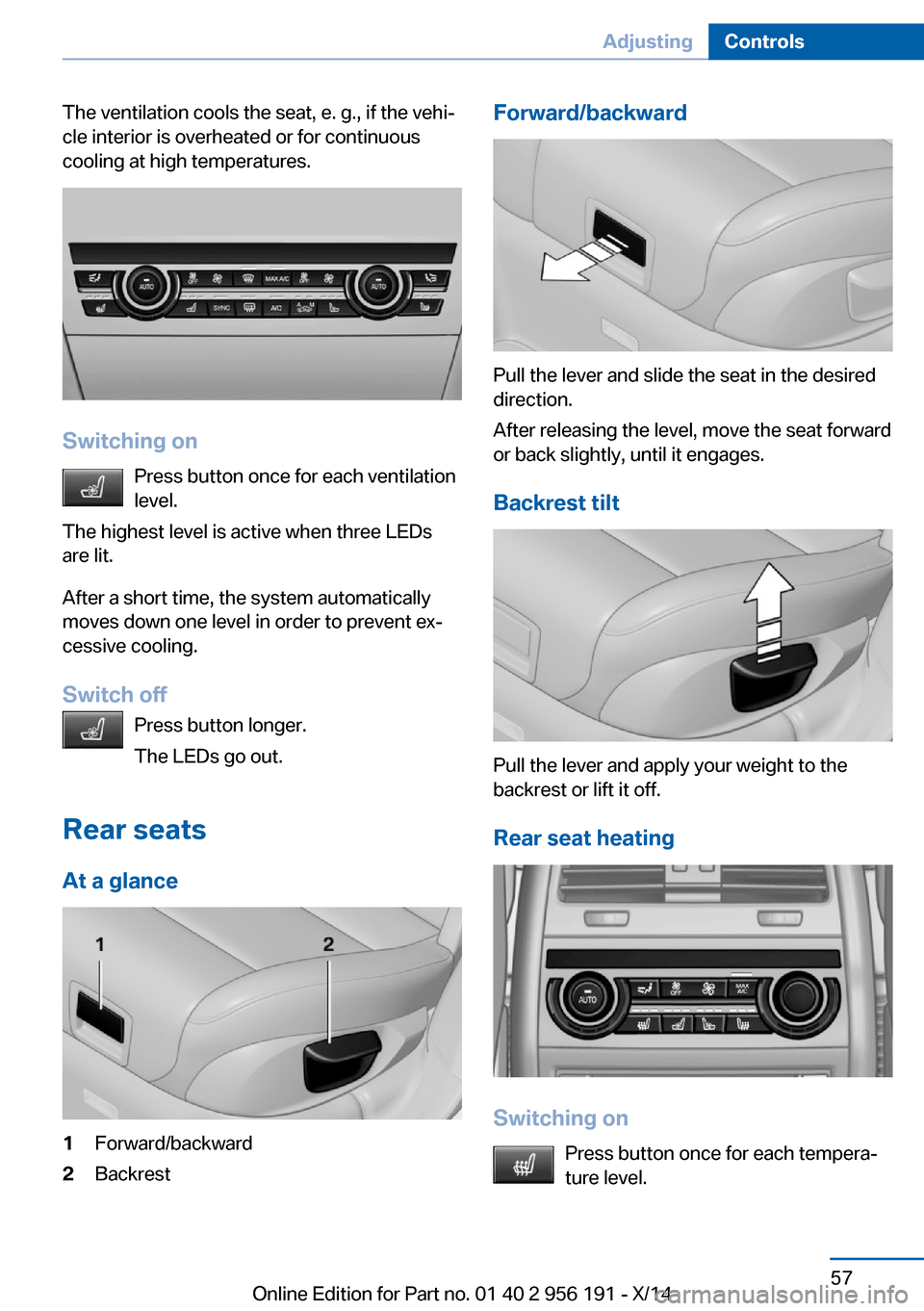
The ventilation cools the seat, e. g., if the vehi‐
cle interior is overheated or for continuous
cooling at high temperatures.
Switching on
Press button once for each ventilation
level.
The highest level is active when three LEDs
are lit.
After a short time, the system automatically
moves down one level in order to prevent ex‐
cessive cooling.
Switch off Press button longer.
The LEDs go out.
Rear seats At a glance
1Forward/backward2BackrestForward/backward
Pull the lever and slide the seat in the desired
direction.
After releasing the level, move the seat forward
or back slightly, until it engages.
Backrest tilt
Pull the lever and apply your weight to the
backrest or lift it off.
Rear seat heating
Switching on Press button once for each tempera‐
ture level.
Seite 57AdjustingControls57
Online Edition for Part no. 01 40 2 956 191 - X/14
Page 69 of 259
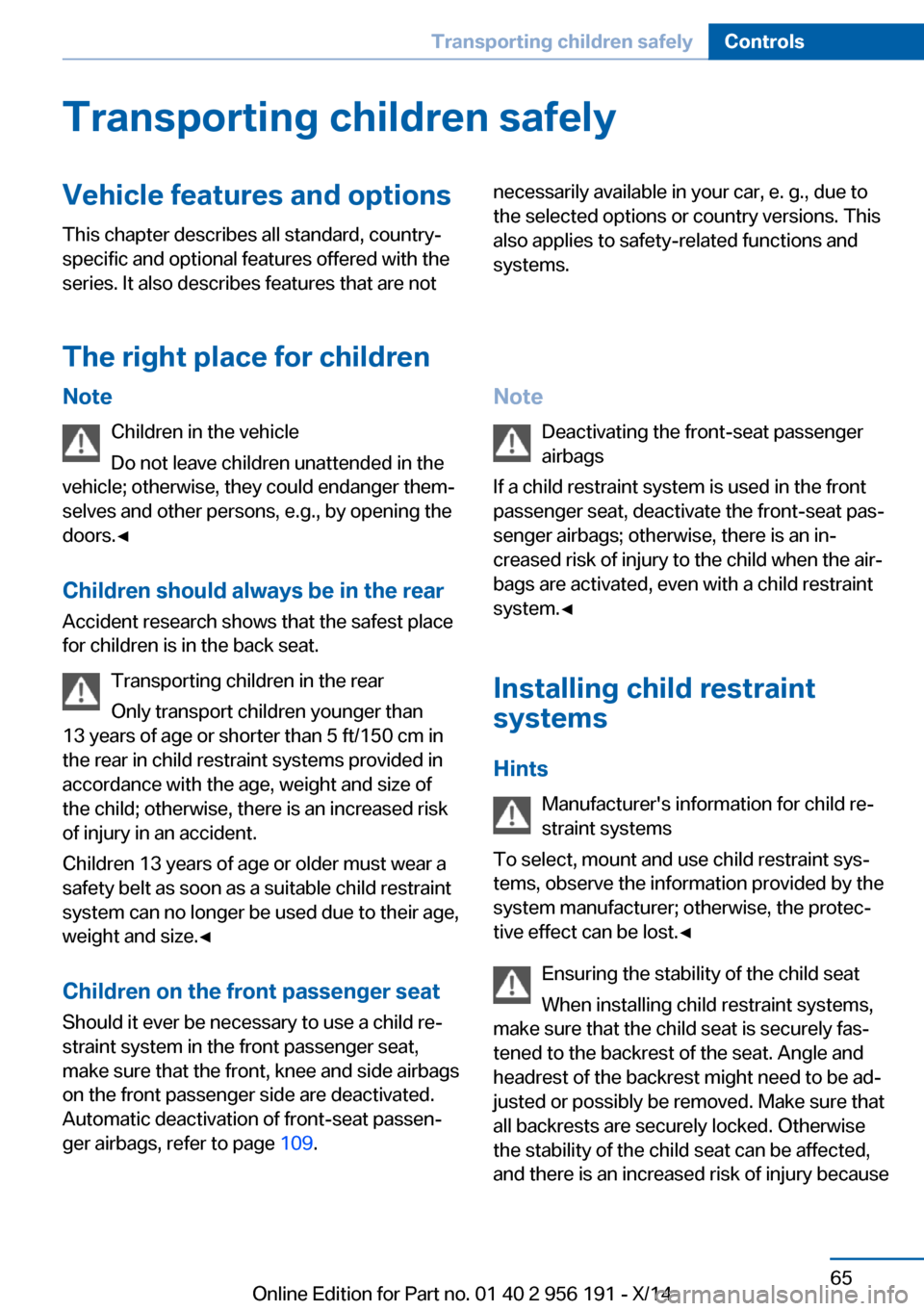
Transporting children safelyVehicle features and optionsThis chapter describes all standard, country-
specific and optional features offered with the
series. It also describes features that are notnecessarily available in your car, e. g., due to
the selected options or country versions. This
also applies to safety-related functions and
systems.
The right place for children
Note
Children in the vehicle
Do not leave children unattended in the
vehicle; otherwise, they could endanger them‐
selves and other persons, e.g., by opening the
doors.◀
Children should always be in the rear Accident research shows that the safest place
for children is in the back seat.
Transporting children in the rear
Only transport children younger than
13 years of age or shorter than 5 ft/150 cm in
the rear in child restraint systems provided in
accordance with the age, weight and size of
the child; otherwise, there is an increased risk
of injury in an accident.
Children 13 years of age or older must wear a
safety belt as soon as a suitable child restraint
system can no longer be used due to their age,
weight and size.◀
Children on the front passenger seat
Should it ever be necessary to use a child re‐
straint system in the front passenger seat,
make sure that the front, knee and side airbags
on the front passenger side are deactivated.
Automatic deactivation of front-seat passen‐
ger airbags, refer to page 109.Note
Deactivating the front-seat passenger
airbags
If a child restraint system is used in the front
passenger seat, deactivate the front-seat pas‐
senger airbags; otherwise, there is an in‐
creased risk of injury to the child when the air‐
bags are activated, even with a child restraint
system.◀
Installing child restraint
systems
Hints Manufacturer's information for child re‐straint systems
To select, mount and use child restraint sys‐
tems, observe the information provided by the
system manufacturer; otherwise, the protec‐
tive effect can be lost.◀
Ensuring the stability of the child seat
When installing child restraint systems,
make sure that the child seat is securely fas‐
tened to the backrest of the seat. Angle and
headrest of the backrest might need to be ad‐
justed or possibly be removed. Make sure that
all backrests are securely locked. Otherwise
the stability of the child seat can be affected,
and there is an increased risk of injury becauseSeite 65Transporting children safelyControls65
Online Edition for Part no. 01 40 2 956 191 - X/14
Page 71 of 259
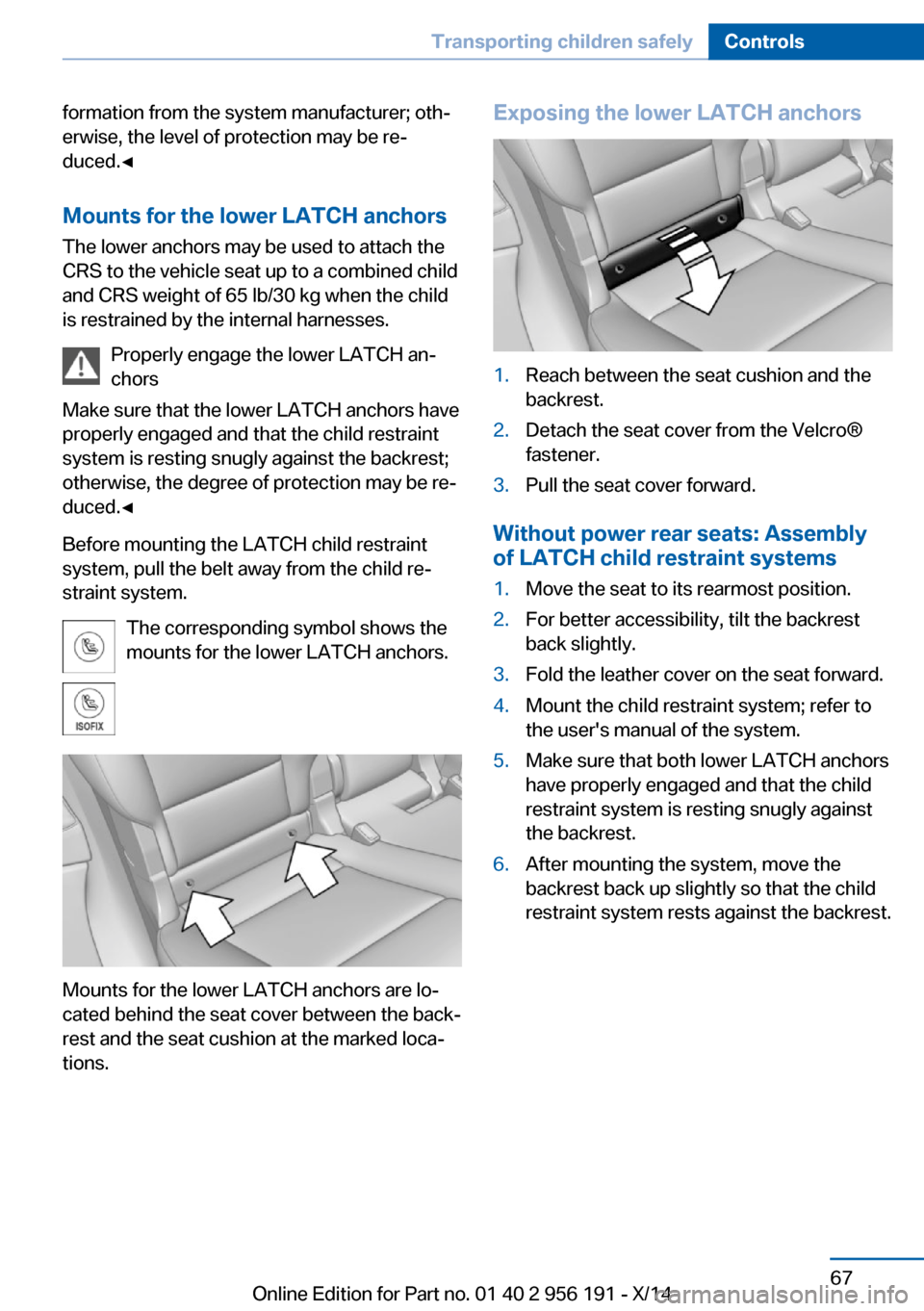
formation from the system manufacturer; oth‐
erwise, the level of protection may be re‐
duced.◀
Mounts for the lower LATCH anchors The lower anchors may be used to attach the
CRS to the vehicle seat up to a combined child
and CRS weight of 65 lb/30 kg when the child
is restrained by the internal harnesses.
Properly engage the lower LATCH an‐
chors
Make sure that the lower LATCH anchors have
properly engaged and that the child restraint
system is resting snugly against the backrest;
otherwise, the degree of protection may be re‐
duced.◀
Before mounting the LATCH child restraint
system, pull the belt away from the child re‐
straint system.
The corresponding symbol shows the
mounts for the lower LATCH anchors.
Mounts for the lower LATCH anchors are lo‐
cated behind the seat cover between the back‐
rest and the seat cushion at the marked loca‐
tions.
Exposing the lower LATCH anchors1.Reach between the seat cushion and the
backrest.2.Detach the seat cover from the Velcro®
fastener.3.Pull the seat cover forward.
Without power rear seats: Assembly
of LATCH child restraint systems
1.Move the seat to its rearmost position.2.For better accessibility, tilt the backrest
back slightly.3.Fold the leather cover on the seat forward.4.Mount the child restraint system; refer to
the user's manual of the system.5.Make sure that both lower LATCH anchors
have properly engaged and that the child
restraint system is resting snugly against
the backrest.6.After mounting the system, move the
backrest back up slightly so that the child
restraint system rests against the backrest.Seite 67Transporting children safelyControls67
Online Edition for Part no. 01 40 2 956 191 - X/14
Page 191 of 259
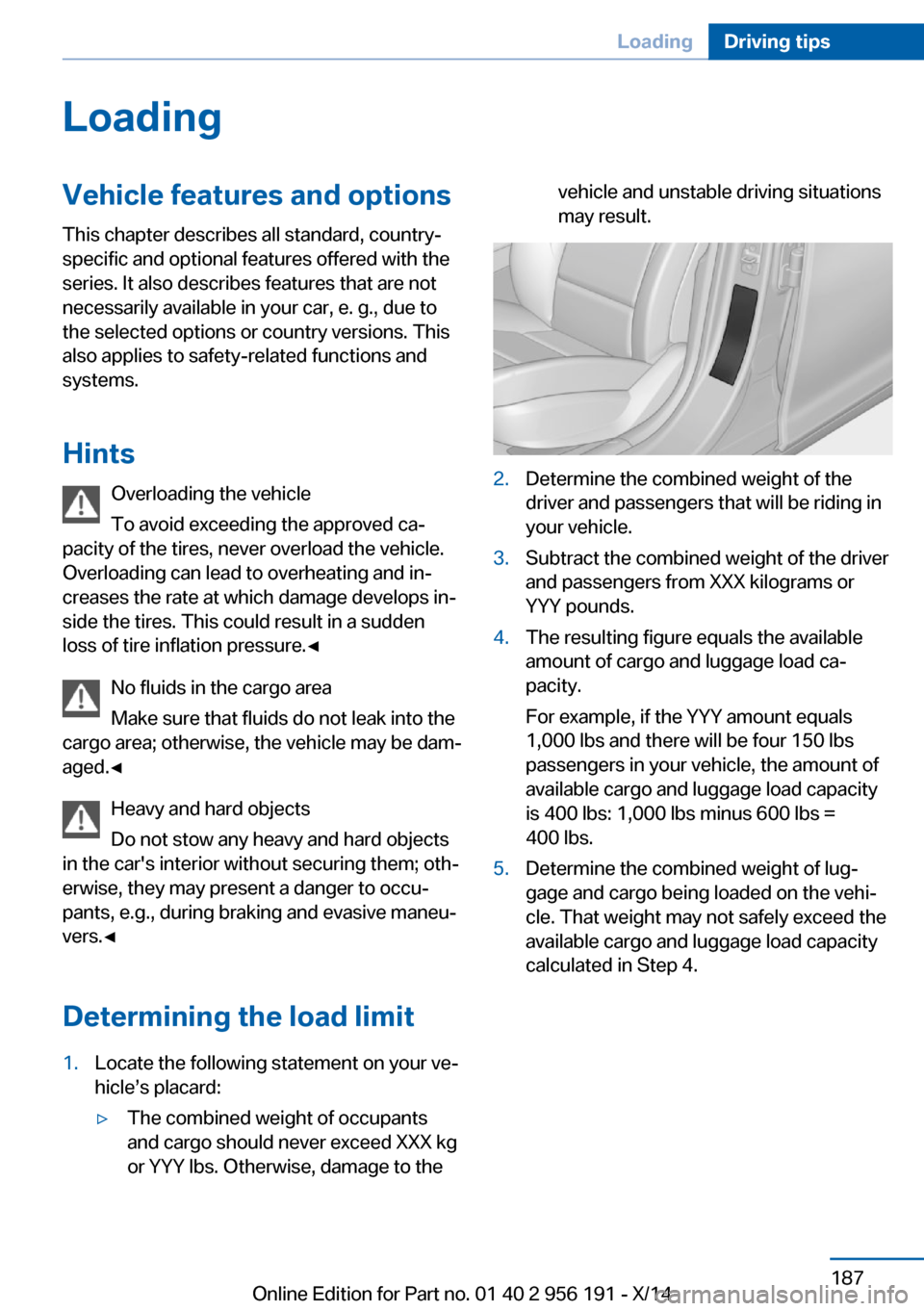
LoadingVehicle features and options
This chapter describes all standard, country-
specific and optional features offered with the
series. It also describes features that are not
necessarily available in your car, e. g., due to
the selected options or country versions. This
also applies to safety-related functions and
systems.
Hints Overloading the vehicle
To avoid exceeding the approved ca‐
pacity of the tires, never overload the vehicle.
Overloading can lead to overheating and in‐
creases the rate at which damage develops in‐
side the tires. This could result in a sudden
loss of tire inflation pressure.◀
No fluids in the cargo area
Make sure that fluids do not leak into the
cargo area; otherwise, the vehicle may be dam‐
aged.◀
Heavy and hard objects
Do not stow any heavy and hard objects
in the car's interior without securing them; oth‐
erwise, they may present a danger to occu‐
pants, e.g., during braking and evasive maneu‐
vers.◀
Determining the load limit1.Locate the following statement on your ve‐
hicle’s placard:▷The combined weight of occupants
and cargo should never exceed XXX kg
or YYY lbs. Otherwise, damage to thevehicle and unstable driving situations
may result.2.Determine the combined weight of the
driver and passengers that will be riding in
your vehicle.3.Subtract the combined weight of the driver
and passengers from XXX kilograms or
YYY pounds.4.The resulting figure equals the available
amount of cargo and luggage load ca‐
pacity.
For example, if the YYY amount equals
1,000 lbs and there will be four 150 lbs
passengers in your vehicle, the amount of
available cargo and luggage load capacity
is 400 lbs: 1,000 lbs minus 600 lbs =
400 lbs.5.Determine the combined weight of lug‐
gage and cargo being loaded on the vehi‐
cle. That weight may not safely exceed the
available cargo and luggage load capacity
calculated in Step 4.Seite 187LoadingDriving tips187
Online Edition for Part no. 01 40 2 956 191 - X/14
Page 192 of 259
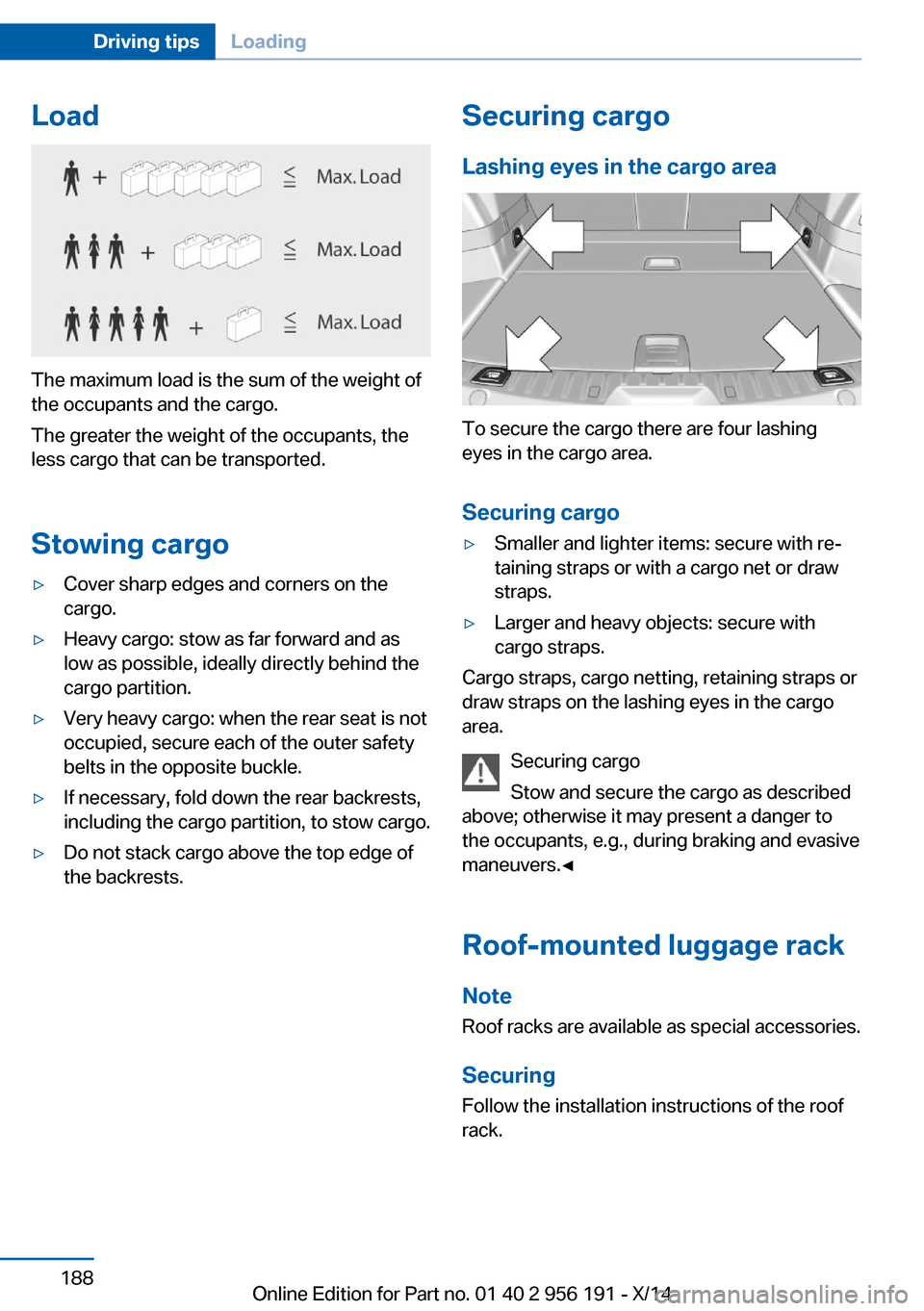
Load
The maximum load is the sum of the weight of
the occupants and the cargo.
The greater the weight of the occupants, the
less cargo that can be transported.
Stowing cargo
▷Cover sharp edges and corners on the
cargo.▷Heavy cargo: stow as far forward and as
low as possible, ideally directly behind the
cargo partition.▷Very heavy cargo: when the rear seat is not
occupied, secure each of the outer safety
belts in the opposite buckle.▷If necessary, fold down the rear backrests,
including the cargo partition, to stow cargo.▷Do not stack cargo above the top edge of
the backrests.Securing cargo
Lashing eyes in the cargo area
To secure the cargo there are four lashing
eyes in the cargo area.
Securing cargo
▷Smaller and lighter items: secure with re‐
taining straps or with a cargo net or draw
straps.▷Larger and heavy objects: secure with
cargo straps.
Cargo straps, cargo netting, retaining straps or
draw straps on the lashing eyes in the cargo
area.
Securing cargo
Stow and secure the cargo as described
above; otherwise it may present a danger to
the occupants, e.g., during braking and evasive
maneuvers.◀
Roof-mounted luggage rack Note
Roof racks are available as special accessories.
Securing
Follow the installation instructions of the roof
rack.
Seite 188Driving tipsLoading188
Online Edition for Part no. 01 40 2 956 191 - X/14
Page 193 of 259
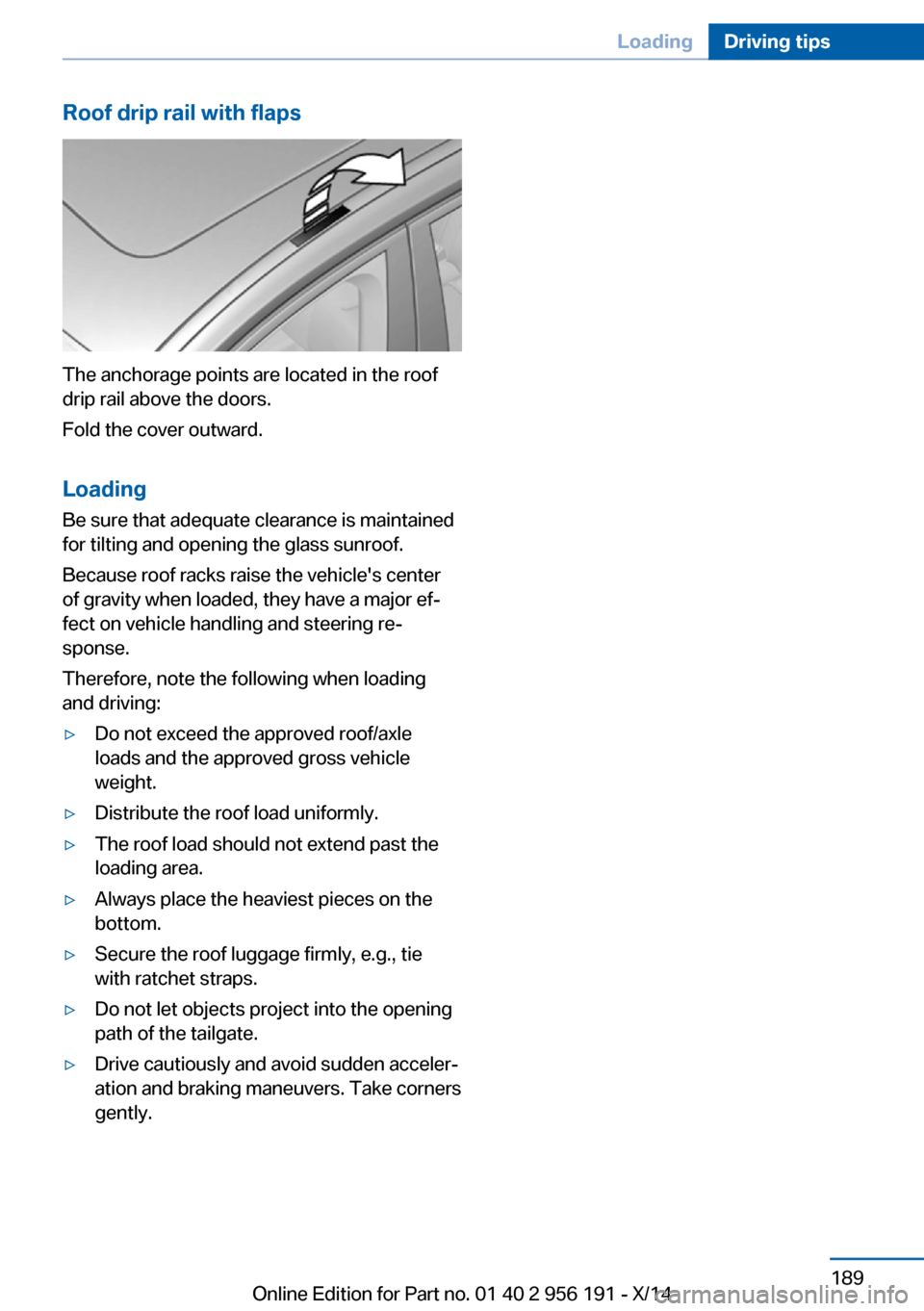
Roof drip rail with flaps
The anchorage points are located in the roof
drip rail above the doors.
Fold the cover outward.
Loading Be sure that adequate clearance is maintained
for tilting and opening the glass sunroof.
Because roof racks raise the vehicle's center
of gravity when loaded, they have a major ef‐
fect on vehicle handling and steering re‐
sponse.
Therefore, note the following when loading
and driving:
▷Do not exceed the approved roof/axle
loads and the approved gross vehicle
weight.▷Distribute the roof load uniformly.▷The roof load should not extend past the
loading area.▷Always place the heaviest pieces on the
bottom.▷Secure the roof luggage firmly, e.g., tie
with ratchet straps.▷Do not let objects project into the opening
path of the tailgate.▷Drive cautiously and avoid sudden acceler‐
ation and braking maneuvers. Take corners
gently.Seite 189LoadingDriving tips189
Online Edition for Part no. 01 40 2 956 191 - X/14
Page 194 of 259
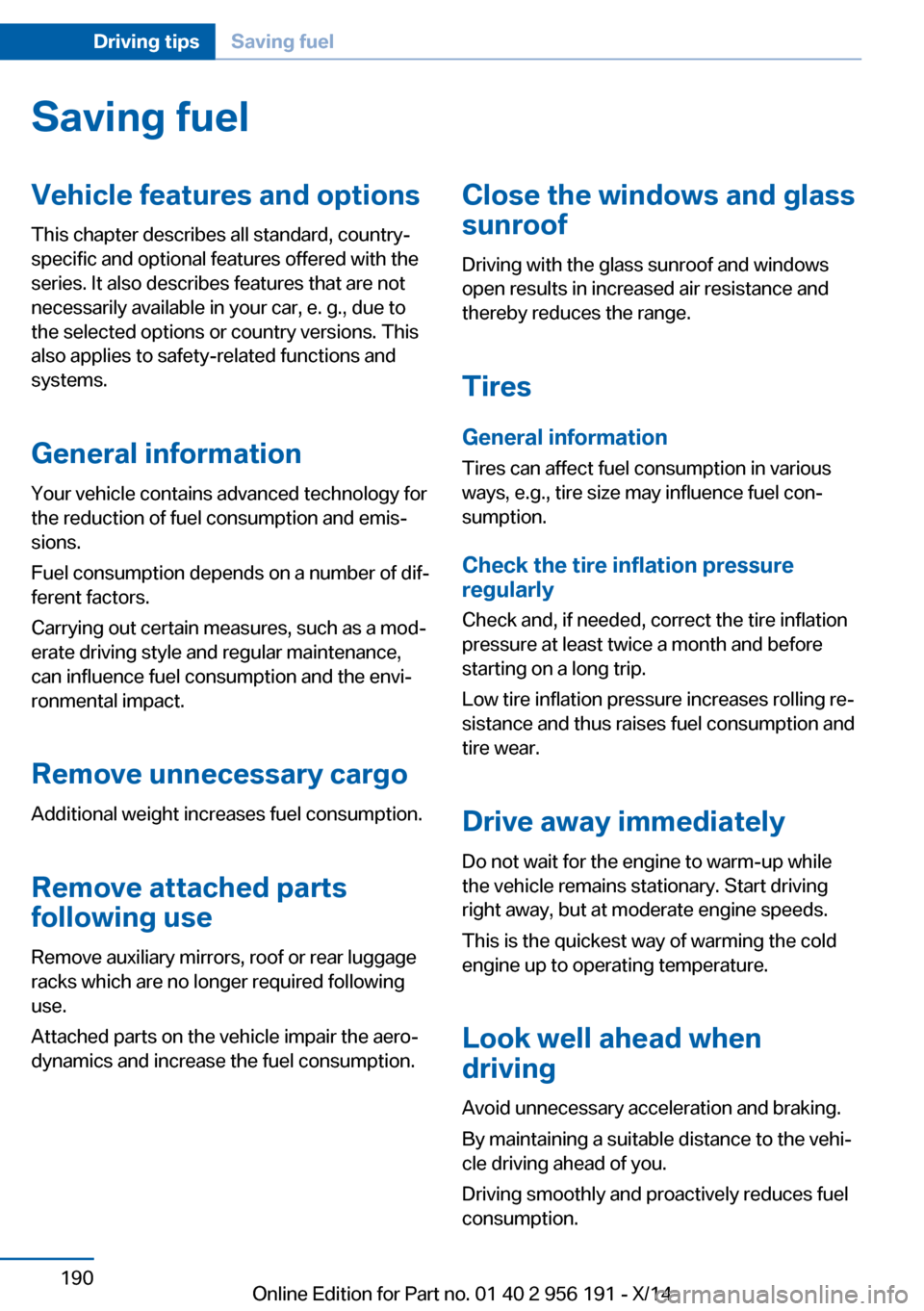
Saving fuelVehicle features and optionsThis chapter describes all standard, country-
specific and optional features offered with the
series. It also describes features that are not
necessarily available in your car, e. g., due to
the selected options or country versions. This
also applies to safety-related functions and
systems.
General information
Your vehicle contains advanced technology for
the reduction of fuel consumption and emis‐
sions.
Fuel consumption depends on a number of dif‐
ferent factors.
Carrying out certain measures, such as a mod‐
erate driving style and regular maintenance,
can influence fuel consumption and the envi‐
ronmental impact.
Remove unnecessary cargoAdditional weight increases fuel consumption.
Remove attached parts
following use
Remove auxiliary mirrors, roof or rear luggage
racks which are no longer required following
use.
Attached parts on the vehicle impair the aero‐
dynamics and increase the fuel consumption.Close the windows and glass
sunroof
Driving with the glass sunroof and windows
open results in increased air resistance and
thereby reduces the range.
Tires
General information Tires can affect fuel consumption in various
ways, e.g., tire size may influence fuel con‐
sumption.
Check the tire inflation pressure
regularly
Check and, if needed, correct the tire inflation
pressure at least twice a month and before
starting on a long trip.
Low tire inflation pressure increases rolling re‐
sistance and thus raises fuel consumption and
tire wear.
Drive away immediately
Do not wait for the engine to warm-up while
the vehicle remains stationary. Start driving
right away, but at moderate engine speeds.
This is the quickest way of warming the cold
engine up to operating temperature.
Look well ahead when
driving
Avoid unnecessary acceleration and braking.
By maintaining a suitable distance to the vehi‐
cle driving ahead of you.
Driving smoothly and proactively reduces fuel
consumption.Seite 190Driving tipsSaving fuel190
Online Edition for Part no. 01 40 2 956 191 - X/14
Page 245 of 259
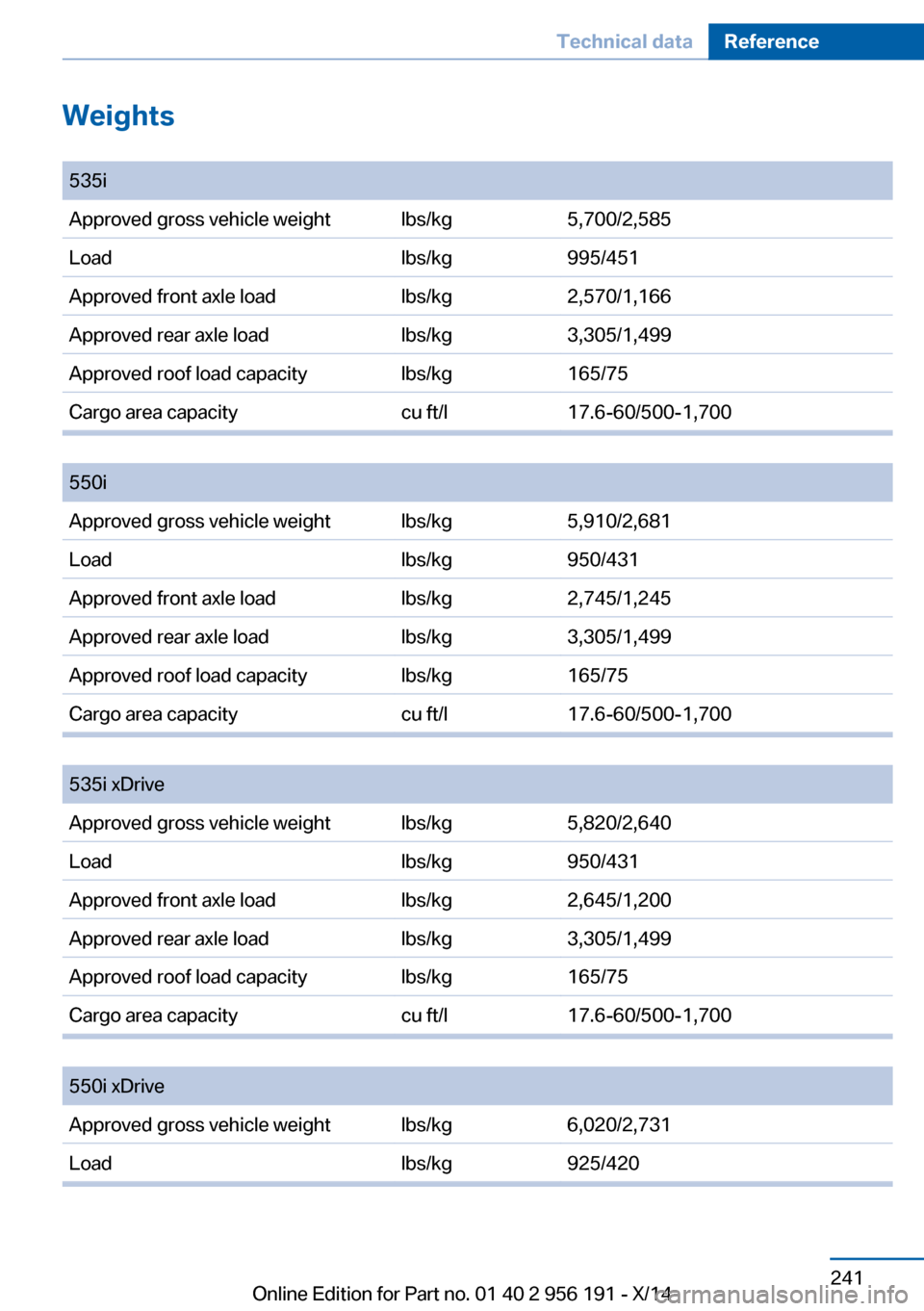
Weights
535iApproved gross vehicle weightlbs/kg5,700/2,585Loadlbs/kg995/451Approved front axle loadlbs/kg2,570/1,166Approved rear axle loadlbs/kg3,305/1,499Approved roof load capacitylbs/kg165/75Cargo area capacitycu ft/l17.6-60/500-1,700
550iApproved gross vehicle weightlbs/kg5,910/2,681Loadlbs/kg950/431Approved front axle loadlbs/kg2,745/1,245Approved rear axle loadlbs/kg3,305/1,499Approved roof load capacitylbs/kg165/75Cargo area capacitycu ft/l17.6-60/500-1,700
535i xDriveApproved gross vehicle weightlbs/kg5,820/2,640Loadlbs/kg950/431Approved front axle loadlbs/kg2,645/1,200Approved rear axle loadlbs/kg3,305/1,499Approved roof load capacitylbs/kg165/75Cargo area capacitycu ft/l17.6-60/500-1,700
550i xDriveApproved gross vehicle weightlbs/kg6,020/2,731Loadlbs/kg925/420Seite 241Technical dataReference241
Online Edition for Part no. 01 40 2 956 191 - X/14
Page 248 of 259
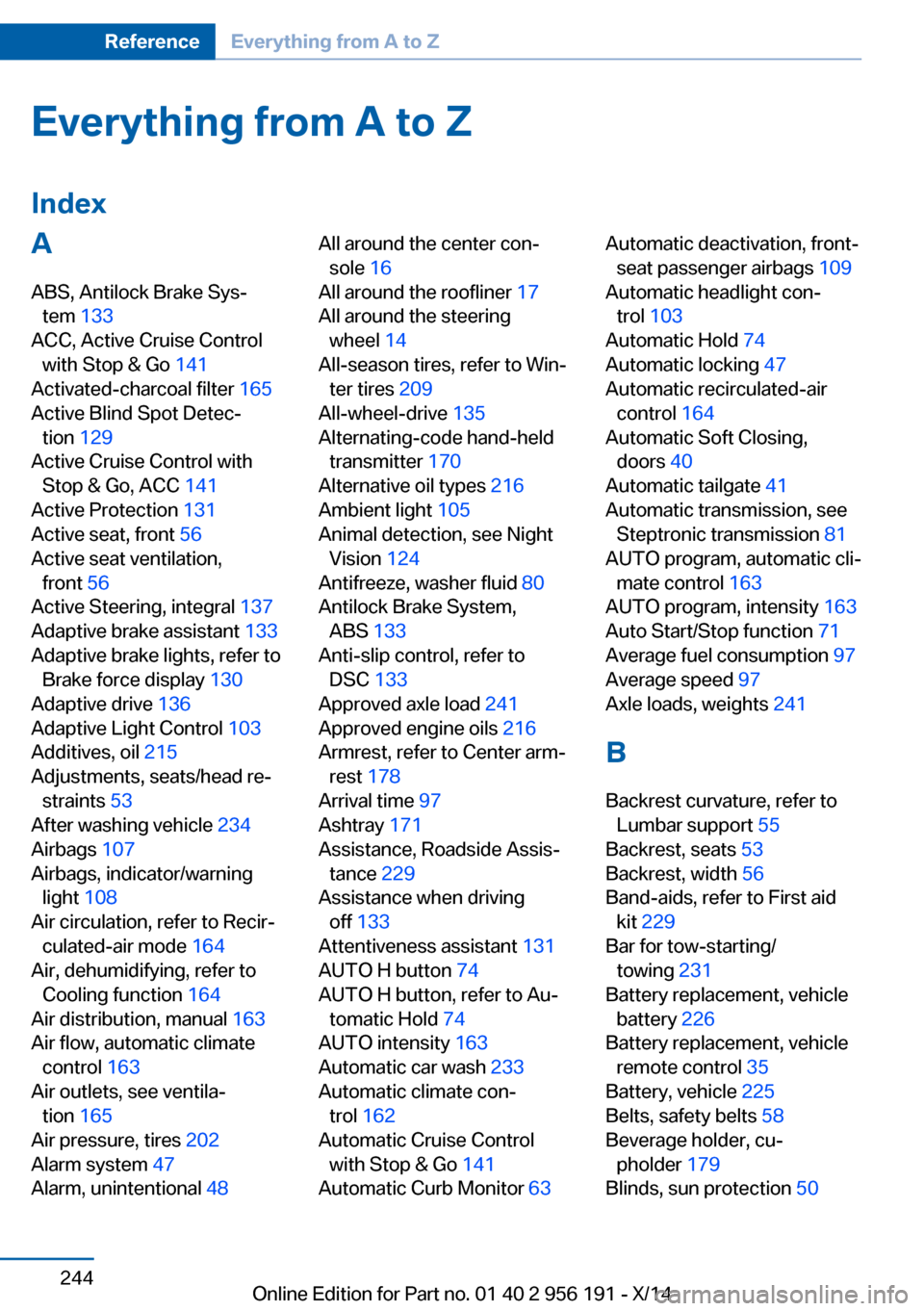
Everything from A to Z
IndexA ABS, Antilock Brake Sys‐ tem 133
ACC, Active Cruise Control with Stop & Go 141
Activated-charcoal filter 165
Active Blind Spot Detec‐ tion 129
Active Cruise Control with Stop & Go, ACC 141
Active Protection 131
Active seat, front 56
Active seat ventilation, front 56
Active Steering, integral 137
Adaptive brake assistant 133
Adaptive brake lights, refer to Brake force display 130
Adaptive drive 136
Adaptive Light Control 103
Additives, oil 215
Adjustments, seats/head re‐ straints 53
After washing vehicle 234
Airbags 107
Airbags, indicator/warning light 108
Air circulation, refer to Recir‐ culated-air mode 164
Air, dehumidifying, refer to Cooling function 164
Air distribution, manual 163
Air flow, automatic climate control 163
Air outlets, see ventila‐ tion 165
Air pressure, tires 202
Alarm system 47
Alarm, unintentional 48 All around the center con‐
sole 16
All around the roofliner 17
All around the steering wheel 14
All-season tires, refer to Win‐ ter tires 209
All-wheel-drive 135
Alternating-code hand-held transmitter 170
Alternative oil types 216
Ambient light 105
Animal detection, see Night Vision 124
Antifreeze, washer fluid 80
Antilock Brake System, ABS 133
Anti-slip control, refer to DSC 133
Approved axle load 241
Approved engine oils 216
Armrest, refer to Center arm‐ rest 178
Arrival time 97
Ashtray 171
Assistance, Roadside Assis‐ tance 229
Assistance when driving off 133
Attentiveness assistant 131
AUTO H button 74
AUTO H button, refer to Au‐ tomatic Hold 74
AUTO intensity 163
Automatic car wash 233
Automatic climate con‐ trol 162
Automatic Cruise Control with Stop & Go 141
Automatic Curb Monitor 63 Automatic deactivation, front-
seat passenger airbags 109
Automatic headlight con‐ trol 103
Automatic Hold 74
Automatic locking 47
Automatic recirculated-air control 164
Automatic Soft Closing, doors 40
Automatic tailgate 41
Automatic transmission, see Steptronic transmission 81
AUTO program, automatic cli‐ mate control 163
AUTO program, intensity 163
Auto Start/Stop function 71
Average fuel consumption 97
Average speed 97
Axle loads, weights 241
B Backrest curvature, refer to Lumbar support 55
Backrest, seats 53
Backrest, width 56
Band-aids, refer to First aid kit 229
Bar for tow-starting/ towing 231
Battery replacement, vehicle battery 226
Battery replacement, vehicle remote control 35
Battery, vehicle 225
Belts, safety belts 58
Beverage holder, cu‐ pholder 179
Blinds, sun protection 50 Seite 244ReferenceEverything from A to Z244
Online Edition for Part no. 01 40 2 956 191 - X/14
Page 250 of 259
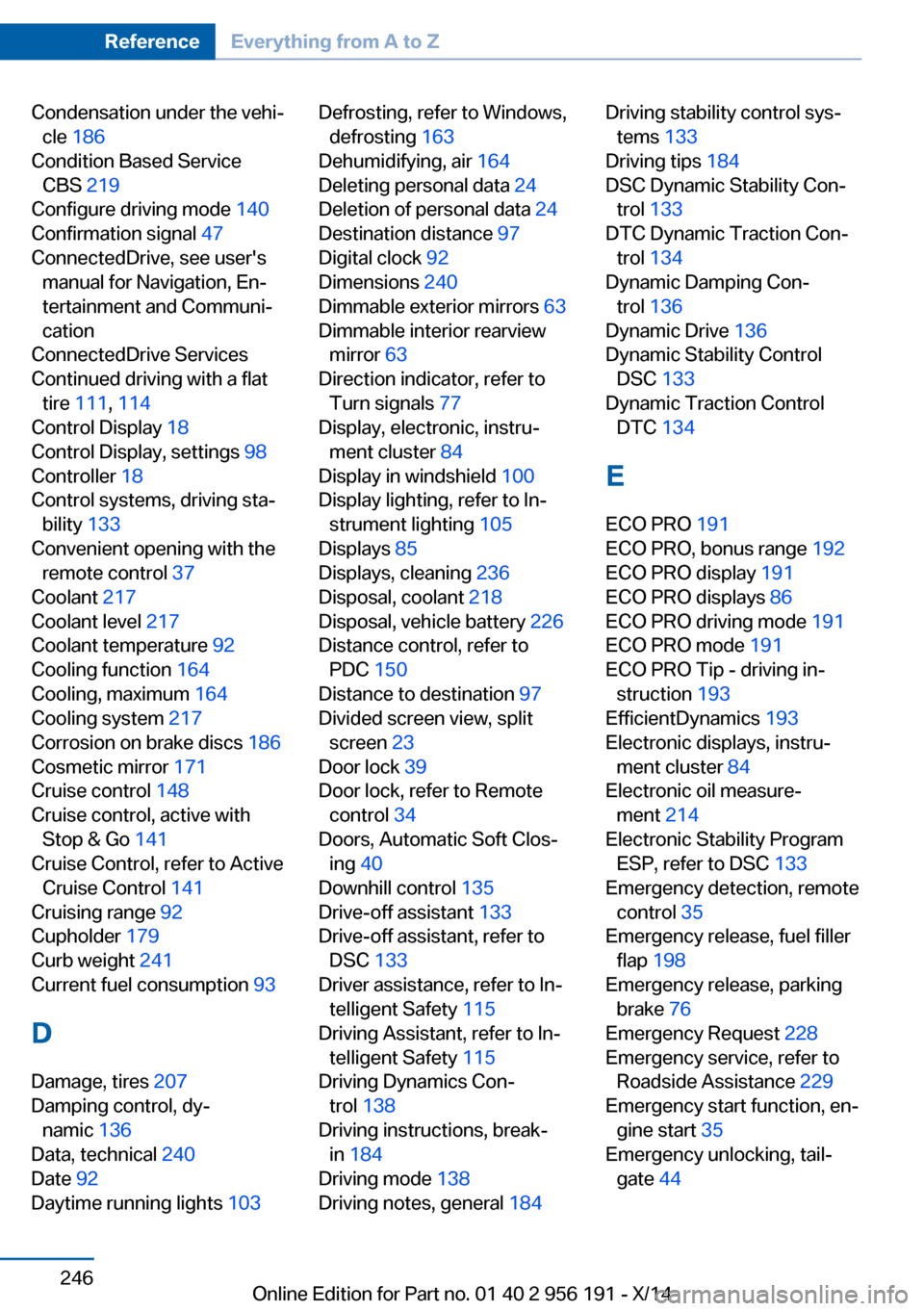
Condensation under the vehi‐cle 186
Condition Based Service CBS 219
Configure driving mode 140
Confirmation signal 47
ConnectedDrive, see user's manual for Navigation, En‐
tertainment and Communi‐
cation
ConnectedDrive Services
Continued driving with a flat tire 111 , 114
Control Display 18
Control Display, settings 98
Controller 18
Control systems, driving sta‐ bility 133
Convenient opening with the remote control 37
Coolant 217
Coolant level 217
Coolant temperature 92
Cooling function 164
Cooling, maximum 164
Cooling system 217
Corrosion on brake discs 186
Cosmetic mirror 171
Cruise control 148
Cruise control, active with Stop & Go 141
Cruise Control, refer to Active Cruise Control 141
Cruising range 92
Cupholder 179
Curb weight 241
Current fuel consumption 93
D
Damage, tires 207
Damping control, dy‐ namic 136
Data, technical 240
Date 92
Daytime running lights 103 Defrosting, refer to Windows,
defrosting 163
Dehumidifying, air 164
Deleting personal data 24
Deletion of personal data 24
Destination distance 97
Digital clock 92
Dimensions 240
Dimmable exterior mirrors 63
Dimmable interior rearview mirror 63
Direction indicator, refer to Turn signals 77
Display, electronic, instru‐ ment cluster 84
Display in windshield 100
Display lighting, refer to In‐ strument lighting 105
Displays 85
Displays, cleaning 236
Disposal, coolant 218
Disposal, vehicle battery 226
Distance control, refer to PDC 150
Distance to destination 97
Divided screen view, split screen 23
Door lock 39
Door lock, refer to Remote control 34
Doors, Automatic Soft Clos‐ ing 40
Downhill control 135
Drive-off assistant 133
Drive-off assistant, refer to DSC 133
Driver assistance, refer to In‐ telligent Safety 115
Driving Assistant, refer to In‐ telligent Safety 115
Driving Dynamics Con‐ trol 138
Driving instructions, break- in 184
Driving mode 138
Driving notes, general 184 Driving stability control sys‐
tems 133
Driving tips 184
DSC Dynamic Stability Con‐ trol 133
DTC Dynamic Traction Con‐ trol 134
Dynamic Damping Con‐ trol 136
Dynamic Drive 136
Dynamic Stability Control DSC 133
Dynamic Traction Control DTC 134
E ECO PRO 191
ECO PRO, bonus range 192
ECO PRO display 191
ECO PRO displays 86
ECO PRO driving mode 191
ECO PRO mode 191
ECO PRO Tip - driving in‐ struction 193
EfficientDynamics 193
Electronic displays, instru‐ ment cluster 84
Electronic oil measure‐ ment 214
Electronic Stability Program ESP, refer to DSC 133
Emergency detection, remote control 35
Emergency release, fuel filler flap 198
Emergency release, parking brake 76
Emergency Request 228
Emergency service, refer to Roadside Assistance 229
Emergency start function, en‐ gine start 35
Emergency unlocking, tail‐ gate 44 Seite 246ReferenceEverything from A to Z246
Online Edition for Part no. 01 40 2 956 191 - X/14